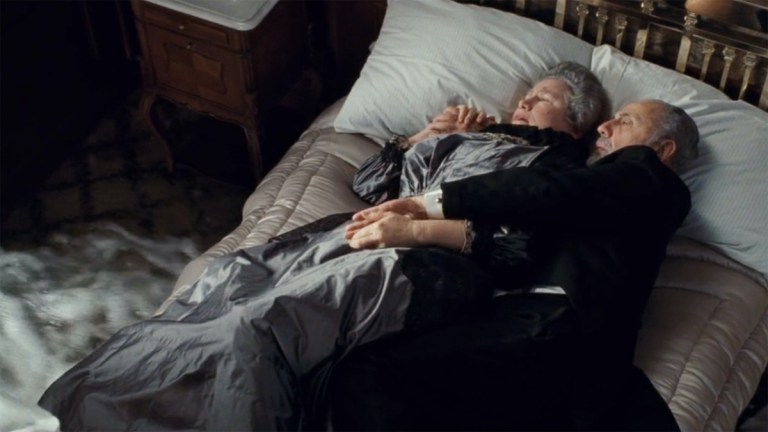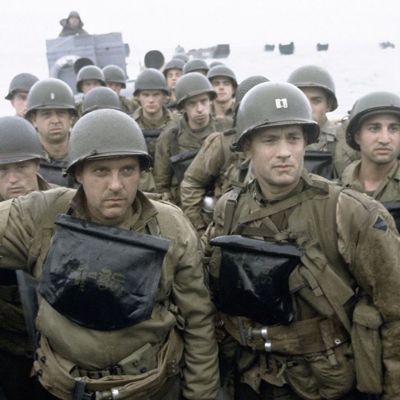The True Story Behind James Cameron’s Titanic
Leonardo DiCaprio and Kate Winslet’s Jack and Rose might’ve been fictional, but the other characters in James Cameron’s Titanic had real stories.

James Cameron’s 1997 blockbusting tearjerker, Titanic, puts an epic love story in the middle of the greatest maritime disaster in the history of the North Atlantic. On April 15, 1912, midway through its maiden voyage from Southampton, England, to New York City, the RMS Titanic struck an iceberg. Because of a severe shortage of lifeboats, 1,517 people died. In the weeks which followed, the luxury liner was said to have been billed as “unsinkable,” but that claim had never been made until after the nautical disaster.
This and other myths have lived on, thanks particularly to Cameron’s romantic (and often fanciful) movie. And yet, not all truths have been lost at sea.
Jack and Rose
Jack Dawson, played by Leonardo DiCaprio, and Rose DeWitt Bukater, played by Kate Winslet as a young woman and Gloria Stuart when elderly, are a myth. They are fictional characters. Jack wasn’t slipped $20 for rescuing Rose, and never taught her how to spit off the side of a ship like a man. But there was a member of the Titanic crew named Joseph Dawson. Born in Dublin, Joseph Dawson worked as a coal trimmer, evening out piles of coal which were shoveled into the ship’s furnaces.
Rose DeWitt-Bukater is the first film character portrayed by two actors who were both nominated for an Academy Award. Winslet was nominated as Best Actress, and Stuart was nominated as Best Supporting Actress. Rose is modeled on Beatrice Wood, who did not travel on the Titanic. Born in San Francisco to wealthy parents, her coming out party was cancelled the same year the Titanic sank.
Beatrice joined the French National Repertory Theatre under the stage name Mademoiselle Patricia, playing more than 60 roles before she was noticed by artist Marcel Duchamp. She was well known by artists during the Dada period, and lived long enough to be invited by James Cameron to the opening of Titanic.
Captain Edward John Smith
Before skippering the Titanic, Capt. Edward John Smith (Bernard Hill) spent 40 years at sea without major incidents. Smith had been working on boats since he was a teenager. He earned a master’s certificate, which is required to serve as captain, in 1875. He became a junior officer with the White Star Line in 1880. He commanded his first ship in 1887. Like many veteran captains, he occasionally ran ships aground, and was captain of the Olympic when it collided with the British cruiser Hawke off the Isle of Wight in 1911, a year before he helmed the Titanic.
The Titanic received iceberg warnings several days into its maiden voyage. Smith adjusted the course but reportedly did not decrease speed. He was away from the bridge when the ship struck an iceberg. The first damage report, from Fourth Officer Joseph G. Boxhall (Simon Crane), found no damage. But a closer inspection from the Titanic’s designer Thomas Andrews (Victor Garber), found five of the ship’s 16 watertight compartments were flooded. The Titanic could have stayed afloat with up to four flooded compartments. At about midnight, Andrews reported the ship would founder within 60 to 90 minutes. Smith gave orders to uncover the lifeboats and alert the passengers at 12:05 a.m.
Because of some of the reported incidents, some historians wonder whether Smith was in a state of shock at the news. Crewmen didn’t lower the lifeboats until 12:45 a.m., and only because Second Officer Charles Lightoller (Jonny Phillips) reminded the captain to give the order.
Smith’s final moments are unknown. Early newspaper reports alleged he shot himself with a pistol. Several witnesses claimed to have seen him swim to a nearby lifeboat with an infant in his arms before swimming back to the Titanic. Some witnesses said he was swept off deck by a wave, others believed he made it to an overturned lifeboat. Smith’s body was never found.
Joseph Bruce Ismay
J. Bruce Ismay (Jonathan Hyde) was born Dec. 12, 1862, near Liverpool, England. His father was the founder of the White Star Line. Educated at Harrow and tutored in France, he travelled the world before becoming the New York company agent for White Star Line. He became head of Ismay, Imrie & Company after his father’s death in 1899, oversaw its acquisition by J.P. Morgan’s International Mercantile Marine Company in 1902, and was named president of IMM in 1904.
In 1907, Ismay met with Lord Pirrie of the Belfast shipbuilding company Harland and Wolff to discuss building a fast luxury liner with huge steerage capacity which would rival the Cunard Line’s RMS Lusitania and RMS Mauretania. Three ships were built, the RMS Olympic, RMS Britannic, and the pride of the fleet, the RMS Titanic. The ship was built by British White Star Lines at a cost of $10 million. It weighed 46,000 tons and was 882.5 feet long.
History puts culpability for the Titanic disaster on Ismay. He reportedly demanded the captain increase speed in spite of the iceberg warnings, but during the U.S. Senate’s Inquiry into the disaster, he testified the ship was never going at full speed and didn’t even have all of the boilers on. Ismay was the company officer who gave the order to cut the number of lifeboats onboard from 48 to the Board of Trade standard minimum of 16, plus 4 collapsible Engelhardt boats. But Ismay also helped crewmen get the lifeboats ready and convinced passengers to board the lifeboats before danger was visibly apparent. Ismay boarded Engelhardt C, the last lifeboat launched, only 20 minutes before the Titanic crashed beneath the waves.
While Ismay was attacked in the press and branded a coward for escaping while so many working-class women and children died, testimony from surviving officers exonerated his actions as in the best interest of the passengers. Ismay retired from IMM and the White Star Line in 1913.
Chief Engineer Officer Joseph Bell
Joseph Bell (Terry Forrestal) was from Farlam, Cumbria, and a family who had been farmers for generations. Born in March 1861, Joseph began his seafaring career as an apprentice engine fitter at Robert Stephensons and Co. in Newcastle. Bell joined the White Star line in 1885, serving on vessels working the waters of New Zealand and New York.
Joseph, was promoted to Chief Engineer on the Coptic in 1891 and married Maud Bates in 1893. By 1911, he was the Chief Engineer on White Star Line’s Olympic before being transferred to the Titanic. His staff consisted of 24 engineers, six electrical engineers, two boilermakers, a plumber, and a clerk. None survived the sinking.
The Unsinkable Molly Brown
Legend has it, Margaret Tobin Brown (Kathy Bates) was called “The Unsinkable Molly Brown” because she helped evacuate the ship, took up one of the oars in the lifeboat, and threatened to throw Quartermaster Robert Hichens (Paul Brightwell) overboard if he didn’t go back to the boat to save more people. The myth says the nickname was plucked from the first words she said upon landing safely in New York: “Typical Brown luck. I’m unsinkable!” But Brown actually got the tag as an insult from Denver gossip columnist Polly Pry as revenge for the story of a local hero being printed in another magazine first.
Molly Tobin was born in Hannibal, Missouri in 1867. Her Irish family was part of a wave of immigrants who came to America after the country’s industrialization. Margaret went to school until age 13 when she began working in a factory. She left in search of better work conditions. She met J.J. Brown, a mining engineer, and they were married on Sept. 1, 1886. While most of their neighbors in the Leadville, Missouri community lived in devastating poverty because of the 1893 Silver Crash, J.J. discovered gold in Ibex Mining’s Little Johnny Mine, where he was made a primary shareholder. The couple became nearly instantaneous millionaires.
Moving to Denver where the Silver Crash also took a heavy economic toll, Margaret became part of the Progressive movement, fighting for public baths, public parks, and other city improvements. The Browns separated in 1909 but never divorced. Margaret and her daughter Helen were on an extended vacation with Col. John Jacob “Jack” Astor IV and Madeleine Astor in 1912 when they heard news about a family member’s health issue at home and booked passage on the first available ship, the Titanic.
After the crash, Margaret was lowered in lifeboat number six, which was equipped to hold 65 passengers, but set off with 21 women, two men, and a twelve-year-old boy onboard. Margaret manned an oar. Her knowledge of foreign languages helped her bring passengers aboard the Carpathia, the first ship to answer the distress call. Margaret distributed blankets and supplies, and got the first-class passengers to donate money to help less fortunate passengers.
Brown continued her Progressive program, helping miners striking against the Colorado Fuel and Iron Company. Twenty people were killed when a battle broke out between the miners and private guards hired by the company in one of the most violent labor conflicts in American history. Once the aftermath and PR battles died down, Margaret moved into her summer home in Newport, Rhode Island where she became involved with Alva Vanderbilt Belmont, the President of the National Women’s Suffrage Association.
The two women spearheaded the National Women’s Trade Union League, which advocated for a minimum wage, an eight-hour workday, and did not distinguish between women of the upper classes and working women.
Margaret wrote newspaper articles, gave public speeches, and was drawn to the radical side of the party, which pushed for a national suffrage amendment. In July 1914, Brown and Belmont organized the Conference of Great Women, which led to Margaret’s bid for a U.S. Senator seat representing Colorado. She shifted her focus when World War I broke out, traveling to France to work for the American Committee for Devastated France.
After WWI, Molly indulged her lifelong passion for the stage, performing in plays in Paris and New York. The 1960 Broadway musical The Unsinkable Molly Brown was based on her life, Debbie Reynolds played her in the 1964 film adaptation. Brown died in her sleep on Oct. 26, 1932, at the Barbizon Hotel in New York City.
Madeleine Astor and Jacob Astor IV
Madeleine Astor (Charlotte Chatton) was five months pregnant when she boarded the Titanic in Cherbourg, France with her husband Col. John Jacob “Jack” Astor IV (Eric Braeden); her husband’s valet, and her maid and nurse. Madeleine was the daughter of William Hurlbut Force, a shipping magnate, and her family was part of Brooklyn high society. The Astors were ending their extended honeymoon which began with a trip from New York on Titanic‘s sister ship, the Olympic.
When the Titanic was sinking, Astor’s husband helped her and her maid into lifeboat four but was denied entry himself by Second Officer Lightoller, who said the boats were for women and children only. Col. Astor perished with the ship. Madeleine Astor gave birth on Aug. 14, 1912. Her late husband’s will was conditional, and when Madeleine married her childhood friend, the banker William Karl Dick, four years after the Titanic tragedy, she lost her stipend from his trust fund.
Isidor and Ida Straus
Here’s a real heartbreaker greater than even Kate and Leo. Remember the image of a couple holding each other and crying as water seeps into their cabin? They were based on the tragically real figures of Isidor and Ida Straus, two of the wealthiest people on the Titanic.
Born into a Jewish family in Otterberg in 1845, back when that village was part of the Kingdom of Bavaria and Germany did not yet exist, Isidor immigrated as a child with his family to the United States. Growing up in Georgia when the Civil War broke out, he even considered joining the Confederacy before instead becoming a blockade runner for the South (think Rhett Butler). After the war, he moved to New York City where he met Ida, a fellow immigrant from the Germanic states.
In New York, Isidor worked at L. Straus and Sons, which quickly became the glass and china department at Macy’s. Yes, that Macy’s. The original one. By 1888, Isidor and his brother became partners in the first major American department store. By 1896 they owned it. Around this time, Isidor even served a single term as a Congressman in the U.S. House of Representatives.
When the Titanic hit an iceberg in 1912, Isidor and Ida were returning home after a holiday in France. As a first class passenger woman from one of the finest cabins on the ship, Ida was almost immediately offered space on a lifeboat. Isidor escorted her to it, but when it came time to get on, she refused. She wouldn’t leave her husband. Isidor was then also offered a spot on the lifeboat beside her, but he also refused, saying he would “not go before other men.”
So both of them declined the lifeboat space and instead gave it to Ida’s maid. One witness said she heard Ida say, “We have been living together for many years. Where you go, I go.” They walked off back toward the neck, never to be seen again.
And the Band Played On
The crew of the RMS Titanic took the adage “women and children first” very seriously. The Titanic‘s eight-member band, led by violinist Wallace Hartley (Jonathan Evans-Jones), never even jockeyed for position. When the band heard the ship was going down, they set up in the first-class lounge and played to keep passengers calm. As the water rose, the band moved to the forward half of the boat deck. Hartley worked for the Cunard ship line before taking the gig on the Titanic. The other band members were violinists George Alexandre Krins and John Law Hume, violist and bassist John Frederick Preston Clarke, cellists John Wesley Woodward, and Roger Marie Bricoux, and pianists Percy Cornelius Taylor and Theodore Ronald Brailey.
According to some passengers, the final song played was “Nearer, My God, to Thee,” a hymn written in 1861 by the Rev. John Dykes. Versions of this song play in the films Titanic (1953), A Night to Remember (1958) and Cameron’s Titanic. This was discounted by Colonel Archibald Gracie, an amateur historian who survived the disaster.
“I assuredly should have noticed it and regarded it as a tactless warning of immediate death to us all, and one likely to create panic,” he is quoted as saying in Steven Turner’s book, The Band That Played On: The Extraordinary Story of the Eight Musicians Who Went Down with the Titanic. He recalled that the band played cheerful songs to keep spirits up. Other survivors also reported hearing songs like “Alexander’s Ragtime Band” and “In the Shadows.”
“Nearer, My God, to Thee” was sung by passengers who survived the 1906 wreck of the SS Valencia and had been played during the impending doom on the decks of the Titanic, but those passengers who heard the song had disembarked earlier than the crew. Wireless operator Harold Bride told The New York Times he heard the song “Autumn” before the ship sank.


